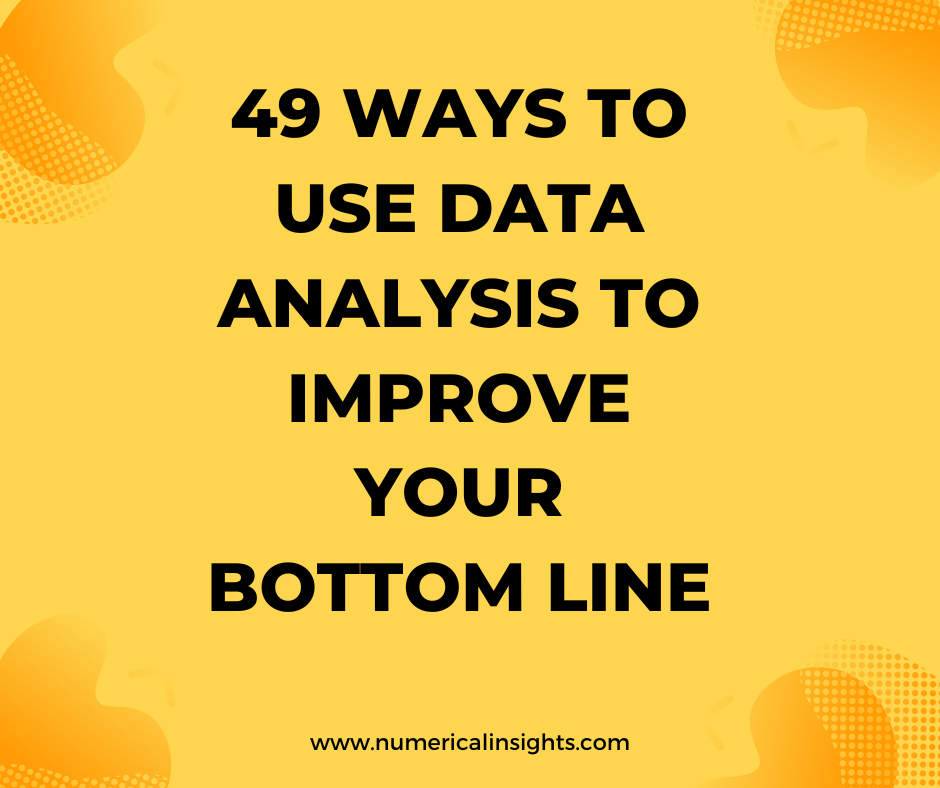49 Ways to Use Data Analysis to Improve Your Bottom Line
“Information is the oil of the 21st century, and analytics is the combustion engine.”
~ Peter Sondergaard, Gartner, Inc.
There are hundreds of ways to use data analysis to improve a business. The challenge is deciding what to analyze first. To help you get started, here are 49 examples of using data to improve your company’s bottom line, gain efficiencies and improve customer satisfaction.
How do you get started?
Learn about inventory management or take this course as a refresher on the basics.
Review the examples below and see which ones are applicable to your business type and industry. (If you print this list or download the PDF version, you can draw a line through the examples that don’t apply to your company.)
For the examples that remain, prioritize those that address the biggest issues your business currently faces. This will get you started with the analyses that yield your “biggest bang for your buck.”
49 Examples of Using Data Analysis to Improve Your Business
Analyze inventory turns (inventory turnover). Data analysis helps identify slow-moving items, excess stock, or obsolete inventory, enabling businesses to make informed decisions on pricing, promotions, and liquidation strategies (products to phase out).
Conducting an ABC analysis categorizes inventory items based on their value, allowing businesses to prioritize management efforts. Data analysis helps identify high-value items that require closer monitoring, while low-value items can be managed more efficiently, potentially reducing costs and optimizing inventory turnover.
Identify customer preferences and trends for better marketing strategies.
Optimize pricing based on market demand and competitor analysis.
Analyze customer feedback to enhance product or service offerings.
Predict sales forecasts and inventory management for efficient supply chain operations.
Analyze customer churn patterns and develop retention strategies.
Use analytics to optimize staffing levels and employee productivity (workforce planning).
Identify cost-saving opportunities through data-driven expense analysis (Pareto expense levels).
Analyze customer demographics to target specific market segments effectively.
Monitor and improve website and app performance through user behavior analysis.
Conduct a lead time analysis. Analyzing lead times (the time taken from placing an order to receiving it) helps optimize inventory levels. By identifying suppliers with shorter lead times, businesses can maintain leaner inventory levels, reducing carrying costs while ensuring timely availability of products. This also helps to identify suppliers who aren’t delivering to their lead times.
Implement personalized marketing campaigns based on individual customer data.
Utilize sentiment analysis to understand customer satisfaction and sentiment.
Conduct A/B testing to optimize marketing and sales strategies.
Analyze social media data to gauge brand perception and sentiment.
Use data analysis to streamline business processes and increase operational efficiency (process mapping).
Monitor and optimize customer acquisition and retention costs.
Identify cross-selling and upselling opportunities through customer behavior analysis.
Use predictive maintenance analytics to reduce equipment downtime.
Analyze customer lifetime value to prioritize and segment customers effectively.
Implement data-driven decision-making processes for inventory management and purchases.
Analyze market trends and competition to identify new business opportunities.
Optimize advertising campaigns based on data-driven insights.
Conduct market segmentation analysis for targeted marketing efforts.
Monitor and improve customer satisfaction and loyalty through data analysis.
Analyze employee performance data for training and development opportunities.
Implement real-time analytics for proactive decision-making (but only where real-time data is really needed).
Utilize data analysis to optimize product pricing and profitability (gross margin analysis across channels).
Analyze the customer journey data to improve the customer experience.
Predict and mitigate supply chain disruptions through data analysis (risk analysis, supplier strategy).
Use data analytics to identify production bottlenecks.
Analyze sales data to identify top-performing products and sales channels.
Use data analysis to optimize marketing campaign effectiveness.
Analyze customer behavior to personalize product recommendations.
Monitor and analyze website traffic to optimize conversion rates.
Implement data-driven quality control measures to minimize defects (Pareto of defect root cause).
Analyze customer complaints and feedback to identify areas for improvement (Pareto analysis).
Build a model to predict future workforce needs based on workload drivers and future business plans.
Analyze customer segmentation to tailor marketing messaging and promotions.
Monitor and optimize customer support processes.
Seasonality Analysis: Data analysis allows businesses to identify seasonal patterns in demand. By understanding when demand peaks and dips occur, companies can adjust inventory levels accordingly. This prevents excess inventory during slow periods and ensures sufficient stock during peak seasons.
Analyze customer lifetime value to prioritize sales and marketing efforts.
Analyze customer data to personalize and improve email marketing campaigns.
Optimize email marketing campaigns based on open and click-through rates.
Analyze customer preferences to develop and launch new products.
Utilize data analysis to optimize lead generation and conversion rates.
Analyze customer demographics to target specific geographical markets and customer types.
Analyze patterns in successful workforce hiring in order to optimize recruitment strategies.
Summary
These are just a few examples. The possibilities for using data analysis to improve business performance are numerous. The specific use cases will vary depending on the nature of your business and the challenges that are currently most urgent.

